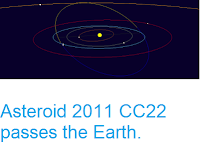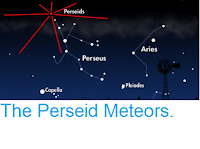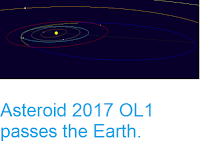Asteroid 2017 PK25 passed by the Earth at a distance of 853 900 km
(2.22
times the average distance between the Earth and the Moon, or 0.57% of
the average distance between the Earth and the Sun), slightly before 2.10 am GMT
on Monday 14 August 2017. There was no danger of the asteroid
hitting us, though had it done so it would have presented no threat.
2017 PK25 has an estimated equivalent diameter of 16-52 m (i.e. it is
estimated that a spherical object with the same volume would be 16-52 m
in diameter), and an object of this size would be expected to explode in
an airburst (an explosion caused by superheating from friction with the
Earth's atmosphere, which is greater than that caused by simply
falling, due to the orbital momentum of the asteroid) in the atmosphere
between 26 and 9 km above the ground, with only fragmentary material
reaching the Earth's surface.
The calculated orbit of 2017 PK25 Minor Planet Center.
2017 PK25 was discovered on 12 August 2017 (two days before its closest approach to the Earth) by the Atlas MLO Telescope at Mauna Loa Observatory in Hawaii. The designation 2017 PK25
implies that the asteroid was the 635th object (object K25) discovered in the first half of August 2017 (period 2017 P).
2017 PK25 has a 268 day orbital period, with an elliptical orbit tilted at
an angle of 25.9° to the plain of the Solar System which takes in to
0.46 AU from the Sun (46% of the distance at which the Earth orbits the
Sun; slightly outside the orbit of the planet Mercury) and out to
1.17 AU (17%
further away from the Sun than the Earth). This means that close
encounters between the asteroid and Earth are fairly common, with the
last thought to have happened in February this year and the next predicted
in August 2020. Although it does cross the Earth's
orbit and is briefly
further from the Sun on each cycle, 2017 NS1 spends most of its time
closer to the Sun than we are, and is therefore classified as an Aten
Group Asteroid.
See also...
Follow Sciency Thoughts on Facebook.







